Our Clarksville docktails evening with Gina and Roger from Two Hull-Areas and Cathy and Mark from Dock Holiday was most enjoyable. As always, we hope to meet them again some day on the water or in Hilton Head.
The next morning was very foggy, and all the spider webs were covered with dewdrops, making them easy to see and brush away! We had a chance for a chat with both Gina and Roger before we left. Roger helped us with a recalcitrant pump out machine, and with casting off.

The river was extremely muddy after the heavy rain of the previous day. Also, there was a huge amount of debris, including whole trees. We concluded that the Cheatham Dam had done another clearing of debris, there was far too much to be the result of one rainstorm, especially at winter pool.
As you move carefully through a debris field, and hear a loud CRACK, you think you have hit a tree. Instead, in these waters, it is most likely to be a jumping silver carp. They are extremely large, and are apparently easily frightened by the noise from boat engines, so they leap out of the water, often hitting the hull. This added to the excitement of transiting through the debris, as we have not seen or heard many carp for the last couple of years. Perhaps the muddy water makes them more nervous than usual.

Just north of Dover, we saw beef cattle down by the water. Dick tells me that some of them looked like a Hereford Angus cross. He said they were definitely not purebreds, but for all that, he is sure they taste good!

We passed Baccalieu II making their way up the Cumberland to Nashville. We were seeing a lot more Loopers in the general area, gradually gathering and waiting to join the main pack that was still stuck in Lake Michigan, waiting for 3 locks on the Illinois River to finish repairs. This will be a tough autumn for most 2023 Loopers. The lock closures meant that they could not get off the Great Lakes as early many would prefer. There are going to be about 300 Looper boats heading down the Illinois starting from October 6th. The AGLCA has arranged flotillas, and negotiated with the Army Corps of Engineers who manage the locks, to pass through the Loopers in groups. There will be many tows waiting, and if everybody tried to just show up, it would be chaotic, not to mention hours of waiting. Once they are off the Illinois River, the next challenge will come from the very low water in the Mississippi and Ohio Rivers. We experienced this last year, and this year is just as bad, in fact worse in some areas. Dredging operations are requiring a 12-hour one way system on the Ohio River. Some of the popular anchorages are silted up and unavailable, and even in Paducah there will be a shutdown of electricity to the dock, while repairs are being made at a nearby substation. Paducah is an important fuel stop for many Loopers, as it is a long distance for some boats to travel from the fuel stop on the Mississippi just south of St Louis, so the timing of the repairs is unfortunate. It’s all part of the adventure, but I am happy that we don’t have to participate in this one!
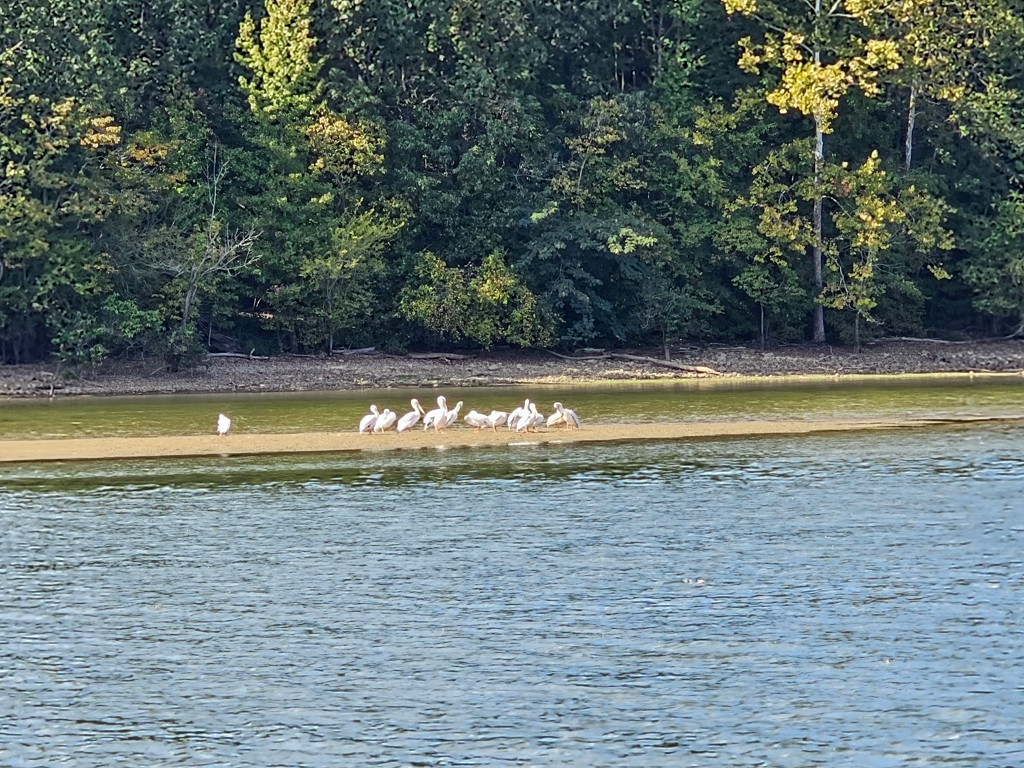
We arrived at Lake Barkley Marina just before 5pm. We had to approach very slowly, first because the route from the Cumberland River is long and complicated, and it is extremely shallow outside the marked channel. Then, there was so much debris in the marina itself, including large logs, that we had no choice but to run into them and push them aside. Local boaters came over to help us get into the slip. I had done most of the preparation during the day, so it was fairly quick to prepare our favourite shrimp sandwiches for supper. The facilities were at least ¼ mile from our assigned slip, making them impractical to use. Between that and the debris, we did not find the marina very enjoyable, and we would not return.


The next day, as we made our way towards Green Turtle Bay, we met another Looper heading south. It was not the nicest experience. The boat was a go-fast motor yacht with a planing hull, but the driver obviously has no concept of how to drive, both for the best fuel efficiency, and for the consideration of other boaters. He had the prow up high, and, as Dick put it, his ass way down in the water, creating a huge wake that continued to bounce us up and down for over a mile due to the resonance set up in the calm water. We could see that the people on board studied us through binoculars, but they neither slowed down nor hailed fellow Loopers. We were too disgusted at the inconsiderate driving to hail them. We later realized that we had in fact met them earlier, they made a point of introducing themselves and giving us their boat card. Strange behaviour.

We were tied up in Green Turtle Bay by 12:30. This was our 5th and last visit to a favourite marina.
In late afternoon we wandered down the dock to chat with other Loopers, and found ourselves sitting on one boat with a group of 6 others, sharing stories and snacks. Later, Dick and I went up to the Yacht Club dining room, shortly joined by Cheri and Pete from Spring Fling, who we had met in Clarksville. Service was chaotic, with long waits for bar service, and then all the food, starters, salads, and main courses, arrived together. The food was good and the company convivial, so we did not mind.
It was an easy day’s run to Paris Landing State Park the next day. We passed a Coast Guard vessel with red and green ATONs in the morning. ATON stands for Aid TO Navigation, and are either green, with a flat top (called cans), or red, with a cone shaped top (called nuns). While there are ATONs on most waterways, those on lakes created by flooded rivers are critically important for both commercial and pleasure traffic. The original river bed will wind back and forth, and only that area is kept dredged to allow passage for tows and larger pleasure craft. Tows occasionally run the ATONs over, and storms, or large debris may also pull them off-station, so the Coast Guard must continually check and adjust positions or add new ones.

The lake is pretty enough, and the channel winds back and forth, but you are usually a long way away from shore, so it is quite a boring day. We were passing the Land Between the Lakes National Recreation Area, a large reserve between the Tennessee and the Cumberland Rivers. The Tennessee River was made into a lake by the Tennessee Valley Authority, to create hydroelectric power in the 1930’s. Barkley Lake was created on the Cumberland River by the construction of a dam in the 1960’s. It was quite interesting to see that the trees were turning colour on the Tennessee River side, but had been mostly still green on the Cumberland River side. Although the Tennessee River is now a lake in its northern reaches, it is still called a river, and the channel follows the original winding river bed. We were tied up by 2pm. Later, two other Loopers, including Cheri and Pete also arrived. We were greeted by the local Harbor Host, who happens to keep his Endeavourcat 36 in that marina.
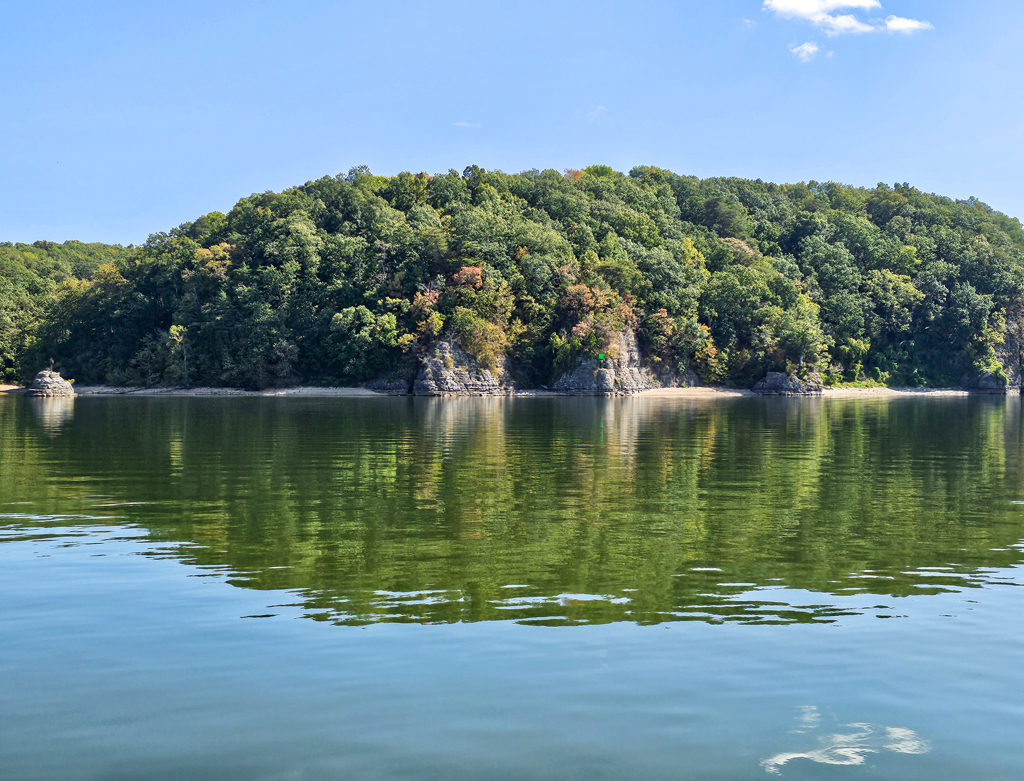
Dick grilled his special home-made burgers for supper. I tried an experiment and used a large English muffin instead of a more conventional bun. I will pronounce it a success, as most other buns get too soggy for my taste when they have been frozen. The burgers were trimmed with sauteed mushrooms and sauteed tomatoes, along with Vermont cheddar slices. It was a very quiet night, and we were out by 8:35 the next morning.
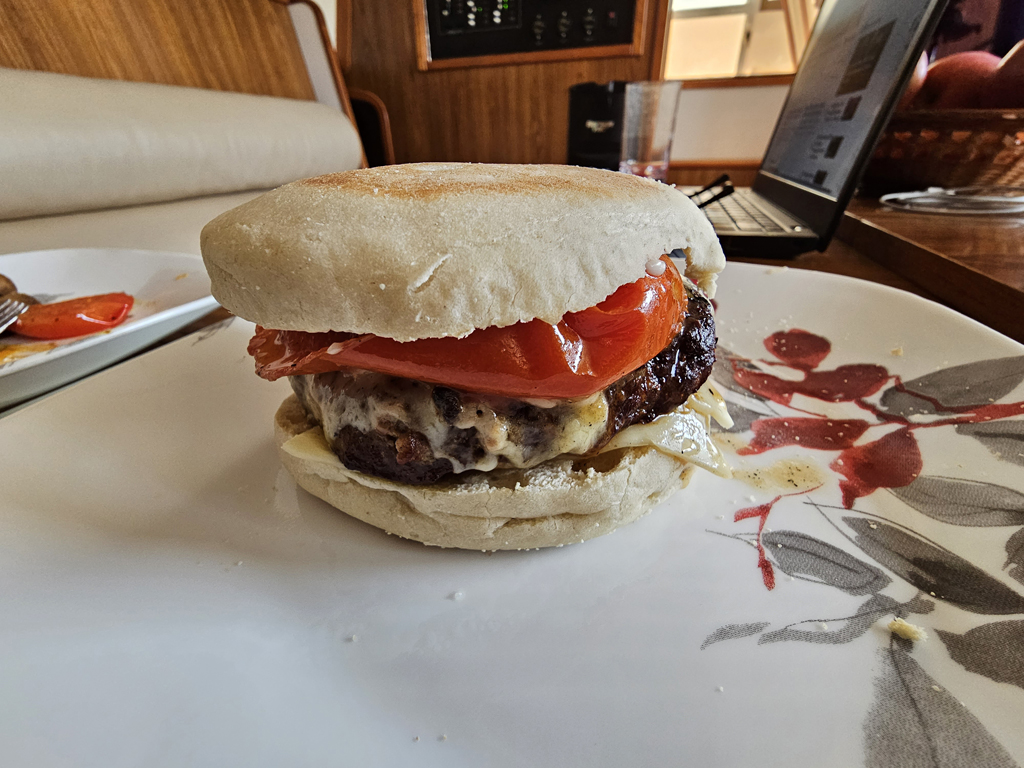
We had another peaceful trip up the Tennessee River to Cuba Landing Marina. Eventually the lake narrows and there is more to see, including pods of pelicans and changing colours of the trees, especially the bald cypress. The Tennessee River is now at “winter pool”, which means that the water depth has been lowered by 5 feet. This allows for winter rains and spring runoff, and helps prevent flooding. Bald cypress are a deciduous conifer, meaning that they have needles, but the needles turn yellow and red in autumn and then drop, unlike most conifers. Once they mature, they are extremely hardy and long lived, and there are some specimens over 100 feet tall, and up to 40 feet or more across. The oldest are thought to be over 2000 years old. The bald cypress that we see on the Tennessee River seem to like to have their feet in the water, and once the depth is lowered, the fascinating root system is revealed. Last year’s colours were a rich gold, while this year many of them are more reddish.


We arrived at Cuba Landing before 3pm, and had time to prepare a platter for docktails with Amy and Wes, who live on their boat in the marina. Wes is a delivery captain, and has lots of stories to tell. We enjoyed a very nice evening with a chilled bottle of local rose (and then some more wine), and all of us were surprised to discover it was past Looper Midnight!

In the morning, the dreaded “tank full” red light came on, telling us two things. First, it was obvious that our pump out in Clarksville had been incomplete, because the red light is a tank full warning for the blackwater tank, and it had only been 4 days. Our normal capacity allows us 10 days. The 2nd thing, happily, the red warning light is still working! It failed several years ago, with unpleasant results, so it had been fixed. Until it comes on, you can never be sure it hasn’t failed again, especially if you time your pump outs, as we do, to avoid being full! After breakfast, Dick walked over to the marina office to pay, and was able to arrange for the pump out boat to come to our dock right away. We were out of the marina by 10:10, only about ½ hour later than originally planned.


As we made our way up the Tennessee River, we were continually reminded of the extremes of weather in this area. All the houses along the riverbank are built high up on stilts, so they are protected from flooding. The river would have to rise at least 20 feet before it even touched the base of the pillars, the anticipated volume of water must be incredible. We also saw places where houses had been destroyed by tornadoes. In one place only half of the house was damaged, in another the house was trashed, and yet the neighbours on either side appeared to be unaffected. I am very glad that we did not see any violent weather events when we were underway in June and July.


We anchored behind Swallow Bluff Island by 4:30. It seemed like a very long day, even though it was our normal travel hours. It was a dull day, so although the fall colours were beautiful, the light was completely flat and there were no photography opportunities as I had hoped.
We had a very quiet night, once local boaters stopped racing through the channel past us, and there was a glorious sunrise for our last morning on the water this year.


We passed Cherry Mansion, where General Ulysses S. Grant’s breakfast was interrupted by couriers with the news that the Battle of Shiloh had begun. Later we passed Shiloh National Cemetery, seen through the trees above Pittsburgh Landing. The Battle of Shiloh was fought from April 6th to 7th in 1862. It was one of the bloodiest battles of the Civil War, with nearly 24,000 casualties. Although they won the battle, the Union army had higher casualties. Afterwards, there was much criticism of the generals on both sides. The Confederate General, Albert Sidney Johnston, lost his life during the battle. He chose to lead from the front, and sent his personal physician away to tend other casualties. He was shot in the leg and bled to death, almost certainly a preventable death. The loss of Johnston was considered by Jefferson Davis, the Confederate President, to be the main reason for the loss of the entire Western Theatre to Union forces. The site of the battle was between Pittsburgh Landing, on the Tennessee River, and a small church named Shiloh, about 3 miles inland towards Corinth. Perhaps it is ironic that Shiloh is a Hebrew word meaning “place of peace”. Union troops were gathering in the area of Pittsburgh Landing with the eventual objective of taking the town of Corinth, where the Confederate army was waiting to defend the important intersection of two railroads. The Union army outnumbered the Confederates, with more divisions on the way, so the Confederates decided to make a surprise attack, hoping to drive the Union troops off before they could consolidate their forces. It never ceased to amaze me, when I read about battles, how often they are lost through bad judgement, incompetence, and even plain cowardice on the part of the leaders.



Shortly after we passed the town of Satillo, Dick received an email with a picture of Nine Lives. The gentleman told us he had seen us at anchor the previous evening when he was fishing, and had watched for us from his home in Satillo. The friendliness of local people, especially in Tennessee, Kentucky, and West Virginia, was a highlight of this year’s trip.
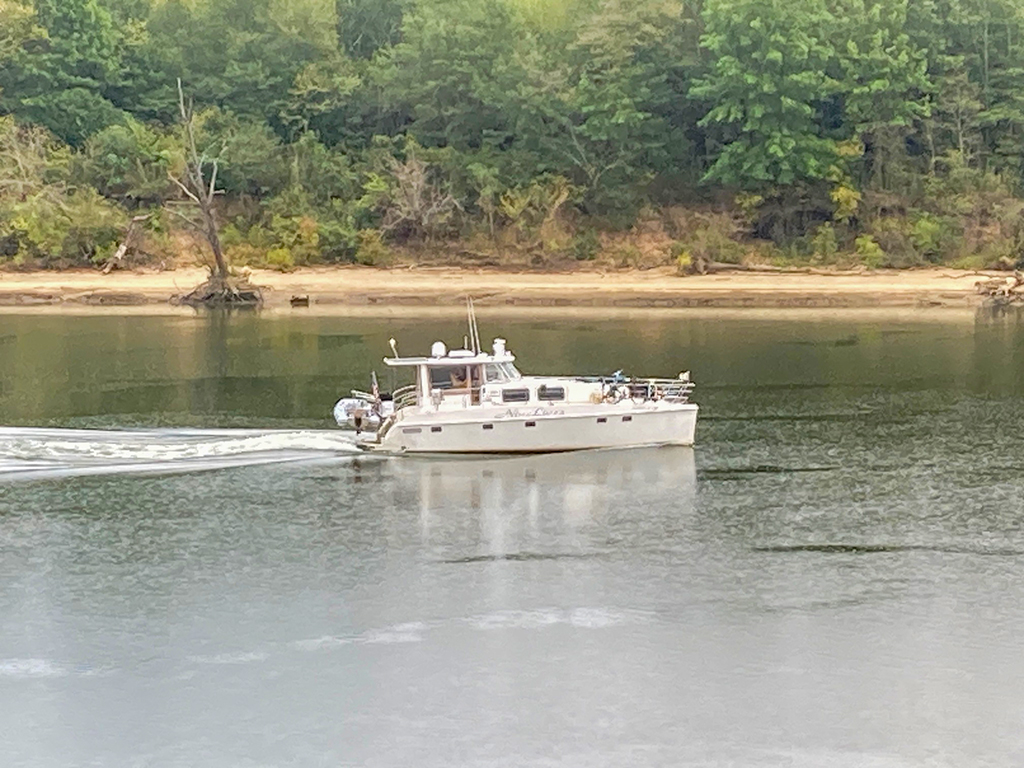
Earlier in the day we had been bounced around by a large yacht with Florida registration, called Rock O. It had been docked behind us at Cuba Landing, and they were obviously in a big hurry to get to the lock at Pickwick. Half an hour from the lock, Dick phoned the lockmaster, and was advised that they had another pleasure craft waiting, and if we could get there within half an hour, they would lock us through at the same time. Dick speeded up. We waited about 30 minutes for the earlier tow to finish and the lock to empty. Rock O, after waking us in their hurry to arrive at the lock, will have waited about 3 hours. We both found that very satisfying! As we left the lock, the lockmaster told us to check their facebook page, as he had taken pictures. Sure enough, there were several very nice images of Nine Lives.



We were into our slip at Aqua Yacht on Pickwick Lake by 3:30. There was just time to hastily prepare a platter for docktails, and we hosted a most enjoyable evening with platinum Loopers Robin and Charlie, harbor hosts at Aqua Yacht. I had not met them in person, although Dick has corresponded with Charlie, and was previously introduced on the docks. They have completed 2 loops, and are thinking about a 3rd. It was great sharing stories with Robin, who has the same role when docking as I do. She is quite familiar with teenage boys and older men who will not take directions for line handling from a woman! We certainly hope to get together again in the future.
Dick had booked a haul out for first thing Friday morning. On our arrival Thursday, he made a point of walking over to the workshop to confirm, and was promised they would come to our dock between 8 and 8:30am. They did, but only to explain that the boat hauled the previous day had only a minor problem to fix, so they would do that and then after it was back in the water, it would be our turn. This rather threw out all our careful plans, so we had to begin packing, laundry, and cabin preparation ahead of when we expected.
The tech arrived shortly after 11am. We took the boat around, and I again had the dubious pleasure of being on board when it was lifted. Then came the challenge of getting off. This time I just couldn’t climb over the rail at the bow with any confidence that I was not going to fall into the (filthy) water. Fortunately, the techs were very understanding, and lowered Nine Lives again and brought a workboat around so I could get off.

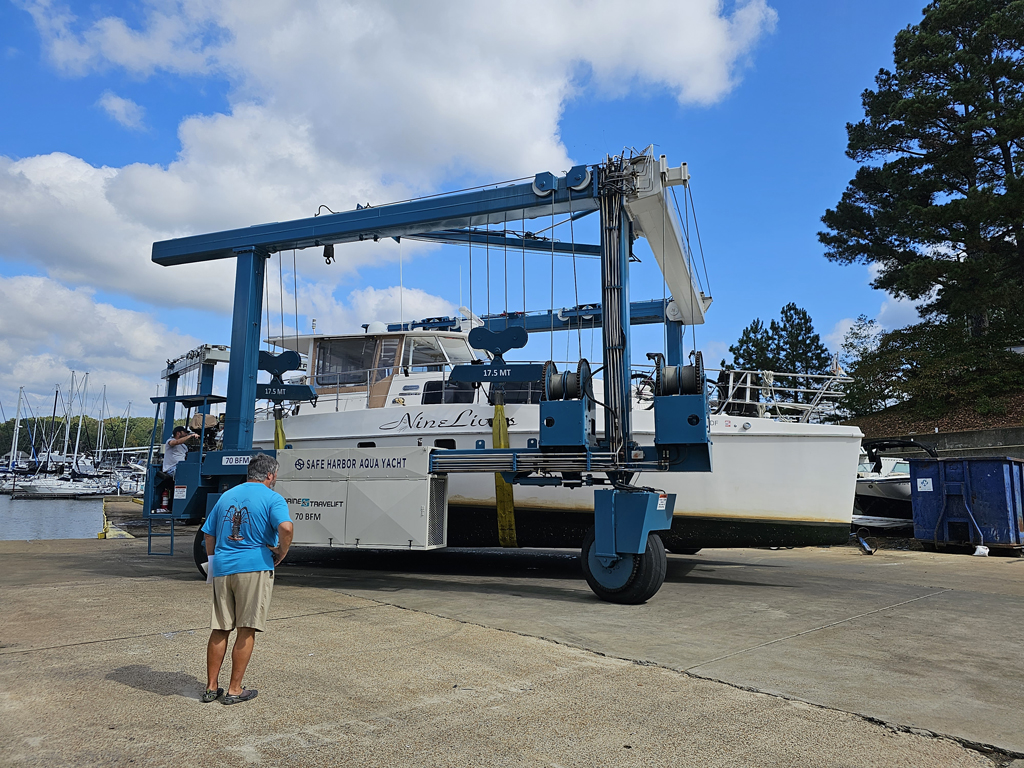
We were delighted to see that the sponsons were completely dry again this year. All that care taken to protect them with fenders pays off! The props need some work, as they are a bit dinged. They were damaged when we were aground in Huntington. On that morning, as we maneuvered to get off the wall, there were horrible grinding noises, now we know what they were. Fortunately, one of the best workshops for propellers is right in the Pickwick area, and it has been some time since ours were tuned anyway.
The first day of preparation to leave the boat we packed all the clothes and the food, and set up the beds. I put all the duvets on the big bed, along with all the pillows and throw cushions, and cover it all with the biggest duvet in a cover I don’t care about. This prevents any accidental damage to the bedlinens when workmen are aboard. On the second day the fridges and freezers are defrosted and cleaned, new clove bags prepared and distributed in the cupboards, wine and liquor packed, and the kitchen and small appliances are thoroughly cleaned, as well as the blades of all the fans. Batteries are taken out of TV remotes and small electronics, the burgee and flag are taken down and stored. We headed to the fuel dock for a last pump out to make sure the tank is completely empty against any possibility of freezing. Once that is done, it is time to drain the fresh water tanks. Dick takes off the shower heads so they don’t crack as they have in the past. He sets up a dehumidifier, two engine room heaters, and a cockpit heater, so we are not relying on the boat heating system. If there was a power failure, the boat system would drain and ruin the batteries, so it is better to have individual heaters and a dehumidifier running off mains power. One last go-round with the vacuum cleaner, roll up the carpets, and put the cockpit cushions into the salon, a final spray to discourage spiders, and we were ready to say goodbye for a year.
We were out by 4:30, both very tired, and needing a rest before the 45-minute drive to Corinth and our favourite local restaurant. Vicari’s did not disappoint, and this time we both ordered things we had not tried before. Dick had stuffed mushrooms to start, and I had red shrimp in butter and parmesan. Dick ordered the mixed grill special, filet, red shrimp, and quail. I tried the grilled pork tenderloin with 2 kinds of ravioli. All was delicious. For dessert, Dick had a limoncello cake, and I had bread pudding. An excellent finish to a successful boating season.




Here are some of our statistics for this season.
States: 8
Miles: 3141 (our longest trip ever)
Days: 106
Hours underway: 360
Engine Hours: 398.4 (also our most ever)
Average speed: 7.5 knots
Maximum speed: 19 knots
Locks: 66
Anchored: 13 nights
Also spent many nights at town walls without power, so ran the generator much more than prior seasons – over 400 hours
Quarts of whiskey consumed: 12 (ish)
This will be the last blog posting for a year. Yes, a year. We will come back to Nine Lives in October of 2024. After attending the AGLCA Annual Fall Rendezvous, we will take time to visit Chattanooga and Knoxville before heading south to Mobile on the Gulf of Mexico. We will “cross our wake” (that is complete our Loop), with a suitable party, in St Petersburg in December. After a break for Christmas, we will resume our winter voyage, heading south to the Florida Keys, and then north up the east coast of Florida and Georgia to finish in Hilton Head. Another party will be required, as we have always considered that we really began our Great Loop from our dock in Hilton Head!


